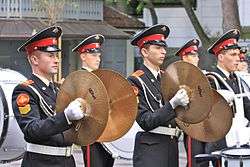Drumline
A drumline, also known as the battery or batterie,[1] is a section of percussion instruments usually played as part of a musical marching ensemble. A drumline can also be a section on their own competing against other drumlines.[2] Marching bands, drum and bugle corps, and indoor percussion ensembles are some examples of groups that include a drumline.

.jpg)
The battery marches on the field as a group as opposed to the stationary front ensemble. The battery usually consists of snare drums, bass drums, tenor drums, and cymbals.[3] In the past, marching timpani were common, as were marching keyboard percussion instruments such as glockenspiels and xylophones. However, due to the inclusion of the front ensemble, all pitched percussion instruments have since been grounded. A relatively small number of bands, mostly at the collegiate level, continue to field such traditional marching keyboard instruments; however, most bands have phased out their use.
Snare drums

Marching snare drums have high-tension heads that manufacturers typically make out of Kevlar or PET film. In the past, snares were typically carried with slings. Slings caused the drums to tilt right causing discomfort in the left hand. Due to this discomfort, traditional grip was created.
Most modern snare drums have rigid over-the-shoulder harnesses that hold the drum with the playing surface parallel to the ground, which affords the option of performing with matched grip. Even with the option of performing matched grip, most competitive groups opt to use traditional grip. Traditional grip allows for more exciting visuals or tricks which are important in the competitive drumming world.
The center, or head, snare player (a position typically held by the most experienced snare drummer) is usually the ensemble's leader.[4] When rehearsing or performing, the center snare may "tap off" the ensemble, setting the tempo with a solo rhythm.
Musically, the snare drum section typically has the most rudimentally challenging "book", or music. The instrument's role is that of the soprano line, typically carrying the melody or the main rhythm of the ensemble.
Tenor drums

Marching tenor drums (also called quads/quints) are single-headed tonal drums. Modern tenor configurations usually have 4 drums and 1 to 2 special effect drums known as spocks or gocks. The spocks are tuned relatively high and are used to play parts that cut through the ensemble. Tenor players add pitch variety to the drumline with drums of different sizes.
Tenor players use matched grip and generally play with mallets with plastic disc-shaped heads, though traditional drumsticks and softer mallets are commonly used to achieve different timbres.[5]
Single tenor drums, also known as flubs, are popular in HBCUs, pipe bands or as starting points for inexperienced drummers, and are beaten using soft or hard mallets. Either in the single or the multiple form, these tenors can be mounted on the chest, like bass drums, or horizontally, like traditional snares.
Tenor drums are aptly the tenor voice of the ensemble, as well as one of the most melodic. Tenor drums often have parts that mirror what the winds or front ensemble is playing. Due the fact that there is often more than one drum, various visuals can be used when performing drum changes such as "cross-overs" or "sweeps".
Marching multiple tenor drums can weigh anywhere between 30 and 45 pounds, depending on the model, and number of drums. This means they are typically the heaviest drums in the drumline.
Cymbals

Marching cymbals are typically pairs of crash cymbals ranging anywhere from 16 to 22 inches in diameter (which are commonly used, though other sizes are also utilized) and are played in a variety of ways. Cymbals are usually bronze and most often held with leather carrying straps. Players in a cymbal line may all carry the same size and type of cymbal, or a variety of instruments may be used. It is not uncommon, however, for each player in a cymbal line to have a different sized pair of cymbals than their peers because it is an efficient way to carry out different sounds and tones depending on what the music and/or percussion director calls for. Cymbal players usually play cymbals by holding and striking them together in front the body, in unison or in split parts. Snare drummers may use them to reproduce a kit sounding part. In addition to being played by the cymbal player, snare drummers may play on the cymbals as ride cymbals or like hi-hats. Cymbals are also used for visual effects due to their reflectiveness while twirling or spinning them. Some tricks include creating letters or shapes and even the "viper," a move in which a center cymbal player jumps and ducks as two cymbal players on each side swing cymbals above and below the jump. Many contemporary field ensembles do not utilize a cymbal line, instead having cymbals played within the front ensemble.
Bass drums

Drumlines most frequently use pitched bass drums as tonal drums split between several percussionists. Marching bass drums, which produce the deepest sound in the Batterie, are larger drums carried on harnesses or straps with the heads facing to the left and right of the player. The musicians carrying the bass drums typically line up in drum size order, but will also assume various positions for the purpose of a drill. Bass drummers use mallets with rounded or cylindrical heads often made of hard felt. High school, Colleges, and Drum Corps drumlines typically consist of four to six different bass drum sizes to ensure enough for a melody. Sometimes, in smaller bands, one may see only two or three bass drummers perform. A bass drum can weigh anywhere between 15 pounds and 40 pounds, depending on the model and size.
Each drummer plays a unique part, though the entire bass drum part is conceived as a whole. This allows for a melodic passage to be carried throughout the bass drumline, having runs of notes that flow up or down the drums and in pitch. In addition to these "split" parts, bass drummers will also have unison notes, where everyone plays at the same time. In addition to splits and unison hits, sometimes the basses will play a rim click, in which they will hit a metal bar attached to the rim of the drum. This is mainly used for subdividing rhythms, and are mainly used when the snares play one or more rim shots and the basses have a unison note on the offbeat.
Front ensemble
The front ensemble (also called the pit) can include any percussion instrument.[3] Typical front ensembles include mallet instruments such as marimbas, xylophones, glockenspiels, vibraphones, timpani, cymbals, concert bass drums, bongos, congas, cowbells, claves, tambourines, gongs, tom-tom drums, chimes, wind chimes, and in some cases drum sets. They may also include a variety of concert and world percussion instruments.[6] Instruments may be mechanically or electronically amplified. Some competitive circuits also allow electronic instruments such as synthesizers and bass guitars, which are typically part of the front ensemble. This wide selection of instruments allows for great timbre variety. Most front ensembles are centered in front of the front sideline of an American football field. However, for aesthetic purposes, some bands choose to put the front ensemble elsewhere on the field to better to suit the show's theme.
In indoor drumline competitions, however, various groups may not necessarily place the front ensemble at the "front" as the name suggests. Rather, the show designers determine placement of the front ensemble by where they would get the best sound quality, depending on the music being played.
See also

References
- "Definition of battery | Dictionary.com". www.dictionary.com. Retrieved 2019-10-21.
- "Drum Bum Glossary". Drum Bum. Retrieved 2007-11-30.
- "Marching Dictionary". Drum Major Resource Center. Archived from the original on 2007-09-05. Retrieved 2007-12-05.
- "What Does It Take To Be Center Snare?". WGI. 2016-02-10. Retrieved 2019-10-21.
- Casella, Jim (2006). Green Beats 06-07. Tapspace Publications LLC and The Cavaliers Drum and Bugle Corps. pp. 12–13.
- Casella, Jim (2006). Green Beats 06-07. Tapspace Publications LLC and The Cavaliers Drum and Bugle Corps. pp. 44–47.
External links
- Drumline Chops An Educational Website for Rudimental Drumming
- Drum Corps International (DCI)
- Drumlines.org